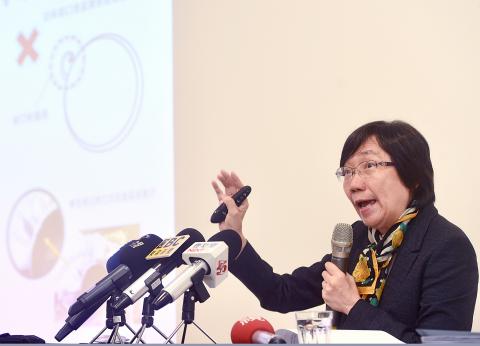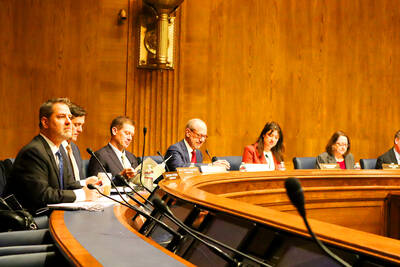The Kaohsiung District Court yesterday convicted 12 people of negligence causing death and other charges following a series of gas explosions that rocked Kaohsiung in 2014, handing out sentences ranging from four years to four years and 10 months, including to former LCY Chemical Corp (李長榮化工) chairman Bowei Lee (李謀偉) and local government officials.
The rulings came after three years of questioning and testimony by 510 persons of interest, witnesses, experts and defendants, and involved the efforts of 12 prosecutors, a court statement said.
Lee was given a four-year sentence, while Kaohsiung City Government Secretary-General Chao Chien-chiao (趙建喬) was handed a four-year, 10-month prison term.

Photo: Chien Jung-fong, Taipei Times
It was the first ruling and it can be appealed.
Five LCY Chemical Corp employees, including a plant manager, supervisors and technicians in the control room, were also convicted of the charges and all received a four-year prison sentences.
Three employees of China General Terminal & Distribution Corp (CGTD, 華運倉儲) were also convicted and handed four-year, six-month sentences.
Two Kaohsiung Sewage System Office technicians, Yang Tsung-jen (楊宗仁) and Chiu Ping-wen (邱炳文), were found guilty of professional negligence and received the heaviest sentences, four-year, 10-month prison terms.
The series of underground explosions, which left 32 people dead and 321 injured, began in Kaohsiung’s Lingya (苓雅) and Cianjhen (前鎮) districts on July 31, 2014, following reports of gas leaks earlier that night.
The court found the 12 defendants guilty of negligence relating to leaking propene from underground pipelines that caused the blasts.
Following an investigation, an underground pipeline belonging to LCY was found to be corroded and the cause of the gas leak.
As a result, Lee and the five LCY employees were convicted for their roles in the incident, which prosecutors attributed to their failure to conduct proper maintenance on a regular basis.
Their failure to monitor the process properly also contributed to the explosions, the ruling said.
The court found Chao, who worked as an engineer in the Kaohsiung Sewage System Office when the blasts took place, and the two technicians working under him, guilty of negligence as they had signed off on an inspection of a culvert containing three pipelines without notifying the relevant companies to inspect them.
The extent to which the defendants sought to settle with the victims was a key point for the judges in determining the sentences, as each had sought to blame others and denied any personal responsibility, Chief Judge Yeh Wen-po (葉文博) said.
LCY paid NT$12 million (US$403,050) to the families of each of the 32 people killed in the blasts, a total of NT$384 million, in line with an agreement reached, Yeh said.
CGTD reached a compensation deal with 63 of the 321 people injured and has paid out more than NT$500 million, the court said.
The district court said it had not received any report from the Kaohsiung City Government indicating that it had reached an agreement with victims to compensate them for damage to their property, Yeh added.
Lee’s attorney said Lee would appeal the ruling.
Although the court handed down its ruling, it had failed to determine the “scientific truth” behind the explosions and Lee wants foreign experts to conduct an examination of the available evidence to determine the real reason for the explosions, which he denies were caused by LCY’s pipeline, the attorney added.
“This ruling is very unfair to me, so I will certainly appeal,” Chao said.

MISINFORMATION: The generated content tends to adopt China’s official stance, such as ‘Taiwan is currently governed by the Chinese central government,’ the NSB said Five China-developed artificial intelligence (AI) language models exhibit cybersecurity risks and content biases, an inspection conducted by the National Security Bureau (NSB) showed. The five AI tools are: DeepSeek, Doubao (豆包), Yiyan (文心一言), Tongyi (通義千問) and Yuanbao (騰訊元寶), the bureau said, advising people to remain vigilant to protect personal data privacy and corporate business secrets. The NSB said it, in accordance with the National Intelligence Services Act (國家情報工作法), has reviewed international cybersecurity reports and intelligence, and coordinated with the Ministry of Justice Investigation Bureau and the National Police Agency’s Criminal Investigation Bureau to conduct an inspection of China-made AI language

BOOST IN CONFIDENCE: The sale sends a clear message of support for Taiwan and dispels rumors that US President Donald Trump ‘sold out’ the nation, an expert said The US government on Thursday announced a possible sale to Taiwan of fighter jet parts, which was estimated to cost about US$330 million, in a move that an expert said “sends a clear message of support for Taiwan” amid fears that Washington might be wavering in its attitude toward Taipei. It was the first announcement of an arms sale to Taiwan since US President Donald Trump returned to the White House earlier this year. The proposed package includes non-standard components, spare and repair parts, consumables and accessories, as well repair and return support for the F-16, C-130 and Indigenous Defense Fighter aircraft,

CHECKING BOUNDARIES: China wants to disrupt solidarity among democracies and test their red lines, but it is instead pushing nations to become more united, an expert said The US Department of State on Friday expressed deep concern over a Chinese public security agency’s investigation into Legislator Puma Shen (沈伯洋) for “secession.” “China’s actions threaten free speech and erode norms that have underpinned the cross-strait ‘status quo’ for decades,” a US Department of State spokesperson said. The Chongqing Municipal Public Security Bureau late last month listed Shen as “wanted” and launched an investigation into alleged “secession-related” criminal activities, including his founding of the Kuma Academy, a civil defense organization that prepares people for an invasion by China. The spokesperson said that the US was “deeply concerned” about the bureau investigating Shen

LIMITS: While China increases military pressure on Taiwan and expands its use of cognitive warfare, it is unwilling to target tech supply chains, the report said US and Taiwan military officials have warned that the Chinese People’s Liberation Army (PLA) could implement a blockade within “a matter of hours” and need only “minimal conversion time” prior to an attack on Taiwan, a report released on Tuesday by the US Senate’s China Economic and Security Review Commission said. “While there is no indication that China is planning an imminent attack, the United States and its allies and partners can no longer assume that a Taiwan contingency is a distant possibility for which they would have ample time to prepare,” it said. The commission made the comments in its annual